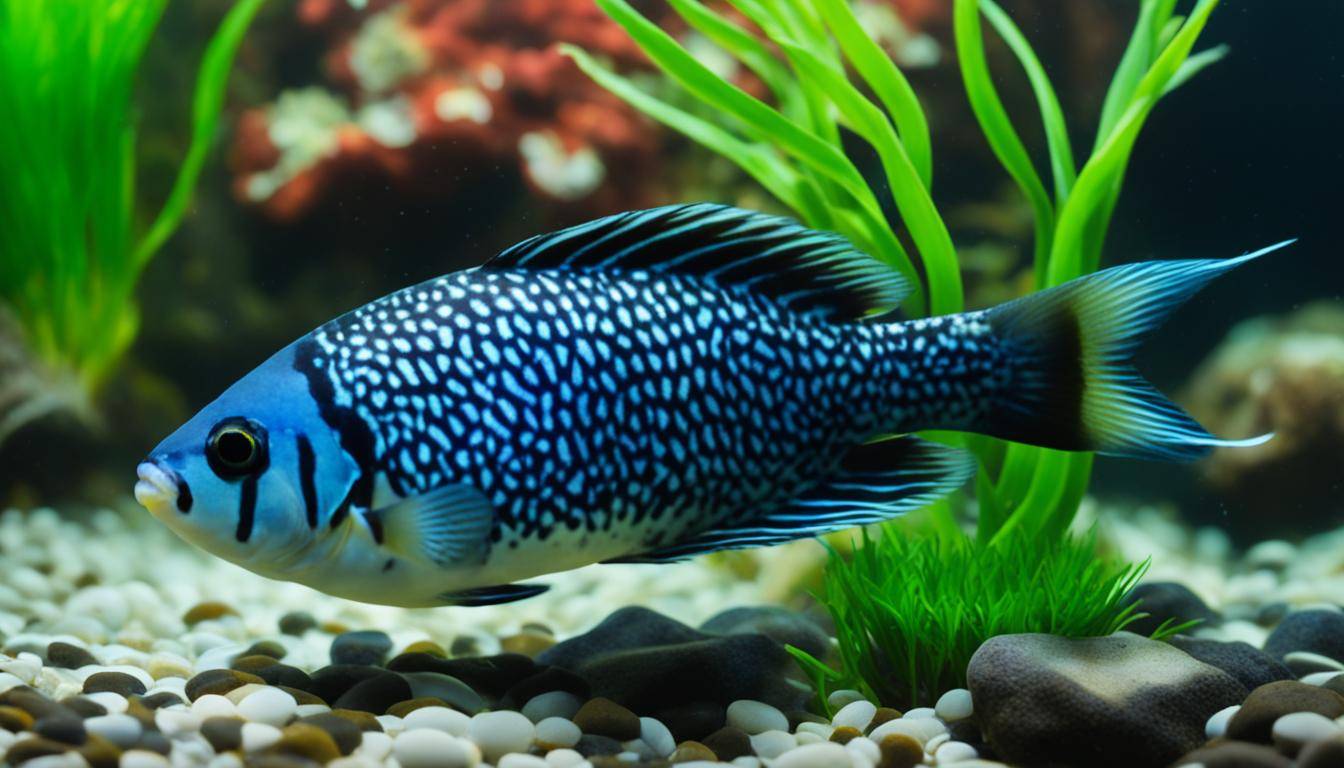Oscar fish, also known as Oscar cichlids, are popular freshwater fish loved by aquarium enthusiasts. Their vibrant colors and unique personality make them a captivating addition to any aquarium. This comprehensive guide will provide you with all the information you need to know about caring for Oscar fish and creating a thriving environment for them.
Key Takeaways:
- Oscar fish are intelligent and can recognize their owners.
- They require a tank size of at least 55 gallons.
- Keep the water temperature between 74-80°F and pH levels between 6-8.
- Feed them a varied diet of high-quality pellets and occasional treats.
- Breeding Oscar fish can be a challenging process.
What are Oscar Fish?
Oscar fish, scientifically known as Astronotus ocellatus, are native to the Amazon basin in South America. They are a popular freshwater cichlid species among aquarium enthusiasts. Oscar fish are commonly found in slow-moving waters with shelters such as tree roots or rocks. Juvenile Oscars typically measure around 2-3 inches in length, but they can grow rapidly and reach sizes of 10-12 inches or more within the first 6-12 months of their lives.
One of the distinctive features of Oscar fish is their vibrant colors and patterns. The tiger oscar, with its red-orange markings, is a particularly popular variation. Other color variations include albino, red, lemon, black, and white, and long fin. These variations add to the visual appeal of Oscar fish and make them a sought-after choice for aquarium enthusiasts.
Oscar fish are known for their unique personality and intelligence. They can recognize their owners and often swim to the front of the tank to greet them. This characteristic behavior adds to the enjoyment of keeping Oscar fish as pets.
Quick Facts:
- Scientific Name: Astronotus ocellatus
- Family: Cichlidae
- Native Habitat: Amazon basin in South America
- Size: Juvenile Oscars measure around 2-3 inches, but can grow up to 10-12 inches or more
- Variations: Tiger oscar, albino, red, lemon, black and white, and long fin
Oscar fish are a fascinating addition to any freshwater aquarium due to their striking appearance and intriguing behavior. In the following section, we will explore the essential steps for setting up a suitable aquarium environment to ensure the optimal health and well-being of Oscar fish.
Setting Up an Aquarium for Oscars
When it comes to setting up an aquarium for Oscar fish, there are a few key factors to consider to ensure the best environment for these vibrant freshwater cichlids. Meeting their size requirements, maintaining the ideal water conditions, and selecting suitable tank mates are crucial for their well-being.
Tank Size and Setup
The size of the tank is of utmost importance when setting up an aquarium for Oscars. Oscar fish are known for their large size and active nature, so it’s recommended to have a tank size of at least 55 gallons to provide them with adequate swimming space. However, for optimal comfort, a larger tank such as a 75-gallon or 90-100-gallon tank is advised.

-
Save
Creating a suitable habitat includes providing hiding spots, such as cave structures or driftwood, which mimic their natural environment. Oscars enjoy rearranging their surroundings, so be prepared for some redecorating!
Water Conditions
Achieving the ideal water conditions is essential for the well-being of Oscar fish. Maintain a water temperature between 74-80°F (23-27°C) to mimic their natural habitat. Keeping the pH level between 6-8 will help create a comfortable environment for them to thrive.
Another crucial aspect is adequate filtration. Oscars produce a significant amount of waste, so investing in a high-quality filtration system is vital. This will help keep the water clean and prevent any potential health issues caused by poor water quality.
Choosing Tank Mates
When selecting tank mates for Oscar fish, it’s important to consider their predatory nature. Oscars are known for their aggressive behavior, especially towards smaller fish that they may perceive as prey. To ensure a harmonious community tank, it’s recommended to choose larger, peaceful fish as tank mates.
“Silver dollars and certain plecos are excellent tank mates for Oscars.”
Silver dollars have similar water requirements and are of similar size, making them suitable companions. Plecos, such as the common pleco (Hypostomus plecostomus), can also coexist peacefully with Oscars, as they are bottom-dwelling fish and less likely to trigger aggression.
However, it’s crucial to avoid smaller fish that can be easily consumed by Oscars. Species like tetras or guppies are not suitable tank mates.
By considering the tank size, water conditions, and compatible tank mates, you can create a thriving aquarium environment for your Oscar fish. Let’s now delve into their diet and feeding habits in the next section.
Oscar Fish Diet and Feeding
Oscar fish are known for their versatility when it comes to their diet. As omnivores, they have the ability to consume a wide range of foods, making them relatively easy to feed. However, providing them with a balanced and nutritious diet is crucial for their overall health and well-being.
The primary food source for Oscar fish should be high-quality pellets specifically formulated for their nutritional needs. These pellets should be the foundation of their diet, offering essential vitamins, minerals, and nutrients to support their growth and immune system.
In addition to pellets, incorporating live foods into their diet can provide enrichment and variation. Treat your Oscar fish to occasional live foods such as crickets, mealworms, freeze-dried krill, and live snails. These live foods not only add excitement to their feeding routine but also serve as a source of natural nutrition.
Remember to offer a variety of food types to ensure that your Oscar fish receives a well-rounded diet. This includes both meaty and plant-based foods. By providing a diverse range of foods, you can ensure that your fish obtains all the necessary nutrients for optimal health.
Tip: Consider adding vitamin and mineral supplements, like Vita-Chem, to support your Oscar fish’s immune system and overall health.
Feeding frequency is an important aspect to consider when it comes to the diet of Oscar fish. While they are small, it is recommended to feed them multiple times a day, ensuring that their nutritional requirements are met. As they grow older, gradually reduce the frequency of feedings to one or two large meals per week. This adjustment helps prevent overfeeding and the associated health issues that can arise.
When feeding your Oscar fish, observe their behavior and adjust the feeding amount accordingly. Overfeeding can lead to obesity and other health problems, while underfeeding can result in malnutrition. Striking the right balance is key to maintaining their optimal weight and overall well-being.

-
Save
Summary
Oscar fish have a diverse diet, with high-quality pellets as their main food source. Incorporating live foods and providing a variety of food types is essential to ensure they receive all the necessary nutrients. It is also important to include vitamin and mineral supplements to support their immune system. Remember to adjust the feeding frequency as your Oscar fish grows to prevent overfeeding or underfeeding. By following these guidelines, you can ensure that your Oscar fish remains healthy and happy for years to come.
Breeding Oscar Fish
Breeding Oscar fish can be a challenging but rewarding process. The first step is determining the sex of your Oscar fish, which can be difficult as males and females look similar. To encourage breeding, you can buy a group of six juveniles and wait for a pair to form naturally. Once a pair is identified, it’s important to move them to a separate tank without other fish to create the right breeding environment.
During the breeding process, the female Oscar fish will lay her eggs on a flat rock or cleared area, and the male will fertilize them. It’s crucial to note that both parents play an active role in guarding the eggs until they hatch. Once the fry have hatched, they should be carefully moved to a smaller grow-out tank and fed tiny foods like live baby brine shrimp.
While breeding Oscar fish can be an exciting endeavor, it requires commitment and responsibility. It’s essential to have a plan for the offspring, as keeping the parents and fry together can lead to the parents preying on their young. Finding suitable homes for the offspring is crucial to their well-being. Remember, breeding Oscar fish requires patience, observation, and the willingness to provide the best care for these amazing creatures.
